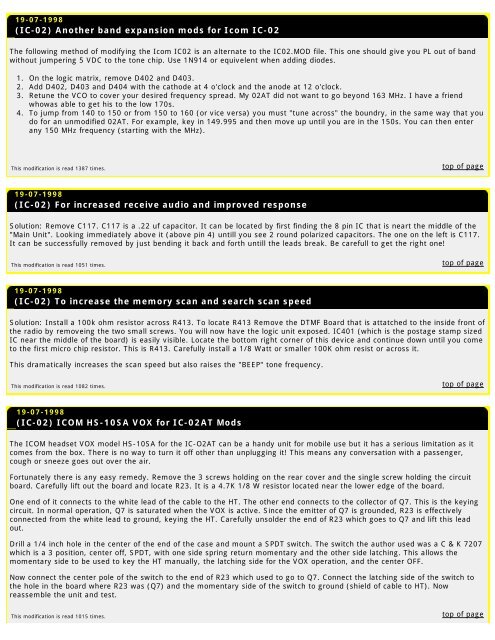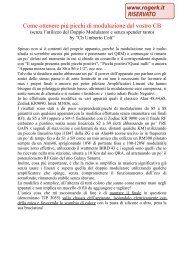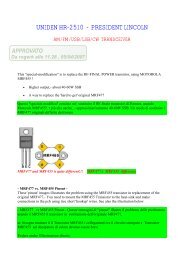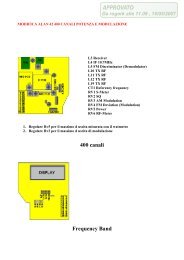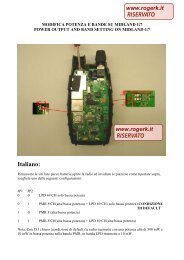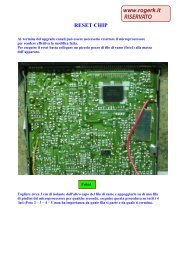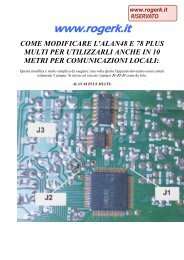Modifications for the ICOM - RogerK
Modifications for the ICOM - RogerK
Modifications for the ICOM - RogerK
- No tags were found...
You also want an ePaper? Increase the reach of your titles
YUMPU automatically turns print PDFs into web optimized ePapers that Google loves.
19-07-1998(IC-02) Ano<strong>the</strong>r band expansion mods <strong>for</strong> Icom IC-02The following method of modifying <strong>the</strong> Icom IC02 is an alternate to <strong>the</strong> IC02.MOD file. This one should give you PL out of bandwithout jumpering 5 VDC to <strong>the</strong> tone chip. Use 1N914 or equivelent when adding diodes.1. On <strong>the</strong> logic matrix, remove D402 and D403.2. Add D402, D403 and D404 with <strong>the</strong> cathode at 4 o'clock and <strong>the</strong> anode at 12 o'clock.3. Retune <strong>the</strong> VCO to cover your desired frequency spread. My 02AT did not want to go beyond 163 MHz. I have a friendwhowas able to get his to <strong>the</strong> low 170s.4. To jump from 140 to 150 or from 150 to 160 (or vice versa) you must "tune across" <strong>the</strong> boundry, in <strong>the</strong> same way that youdo <strong>for</strong> an unmodified 02AT. For example, key in 149.995 and <strong>the</strong>n move up until you are in <strong>the</strong> 150s. You can <strong>the</strong>n enterany 150 MHz frequency (starting with <strong>the</strong> MHz).This modification is read 1387 times.top of page19-07-1998(IC-02) For increased receive audio and improved responseSolution: Remove C117. C117 is a .22 uf capacitor. It can be located by first finding <strong>the</strong> 8 pin IC that is neart <strong>the</strong> middle of <strong>the</strong>"Main Unit". Looking immediately above it (above pin 4) untill you see 2 round polarized capacitors. The one on <strong>the</strong> left is C117.It can be successfully removed by just bending it back and <strong>for</strong>th untill <strong>the</strong> leads break. Be carefull to get <strong>the</strong> right one!This modification is read 1051 times.top of page19-07-1998(IC-02) To increase <strong>the</strong> memory scan and search scan speedSolution: Install a 100k ohm resistor across R413. To locate R413 Remove <strong>the</strong> DTMF Board that is attatched to <strong>the</strong> inside front of<strong>the</strong> radio by removeing <strong>the</strong> two small screws. You will now have <strong>the</strong> logic unit exposed. IC401 (which is <strong>the</strong> postage stamp sizedIC near <strong>the</strong> middle of <strong>the</strong> board) is easily visible. Locate <strong>the</strong> bottom right corner of this device and continue down until you cometo <strong>the</strong> first micro chip resistor. This is R413. Carefully install a 1/8 Watt or smaller 100K ohm resist or across it.This dramatically increases <strong>the</strong> scan speed but also raises <strong>the</strong> "BEEP" tone frequency.This modification is read 1082 times.top of page19-07-1998(IC-02) <strong>ICOM</strong> HS-10SA VOX <strong>for</strong> IC-02AT ModsThe <strong>ICOM</strong> headset VOX model HS-10SA <strong>for</strong> <strong>the</strong> IC-O2AT can be a handy unit <strong>for</strong> mobile use but it has a serious limitation as itcomes from <strong>the</strong> box. There is no way to turn it off o<strong>the</strong>r than unplugging it! This means any conversation with a passenger,cough or sneeze goes out over <strong>the</strong> air.Fortunately <strong>the</strong>re is any easy remedy. Remove <strong>the</strong> 3 screws holding on <strong>the</strong> rear cover and <strong>the</strong> single screw holding <strong>the</strong> circuitboard. Carefully lift out <strong>the</strong> board and locate R23. It is a 4.7K 1/8 W resistor located near <strong>the</strong> lower edge of <strong>the</strong> board.One end of it connects to <strong>the</strong> white lead of <strong>the</strong> cable to <strong>the</strong> HT. The o<strong>the</strong>r end connects to <strong>the</strong> collector of Q7. This is <strong>the</strong> keyingcircuit. In normal operation, Q7 is saturated when <strong>the</strong> VOX is active. Since <strong>the</strong> emitter of Q7 is grounded, R23 is effectivelyconnected from <strong>the</strong> white lead to ground, keying <strong>the</strong> HT. Carefully unsolder <strong>the</strong> end of R23 which goes to Q7 and lift this leadout.Drill a 1/4 inch hole in <strong>the</strong> center of <strong>the</strong> end of <strong>the</strong> case and mount a SPDT switch. The switch <strong>the</strong> author used was a C & K 7207which is a 3 position, center off, SPDT, with one side spring return momentary and <strong>the</strong> o<strong>the</strong>r side latching. This allows <strong>the</strong>momentary side to be used to key <strong>the</strong> HT manually, <strong>the</strong> latching side <strong>for</strong> <strong>the</strong> VOX operation, and <strong>the</strong> center OFF.Now connect <strong>the</strong> center pole of <strong>the</strong> switch to <strong>the</strong> end of R23 which used to go to Q7. Connect <strong>the</strong> latching side of <strong>the</strong> switch to<strong>the</strong> hole in <strong>the</strong> board where R23 was (Q7) and <strong>the</strong> momentary side of <strong>the</strong> switch to ground (shield of cable to HT). Nowreassemble <strong>the</strong> unit and test.This modification is read 1015 times.top of page


